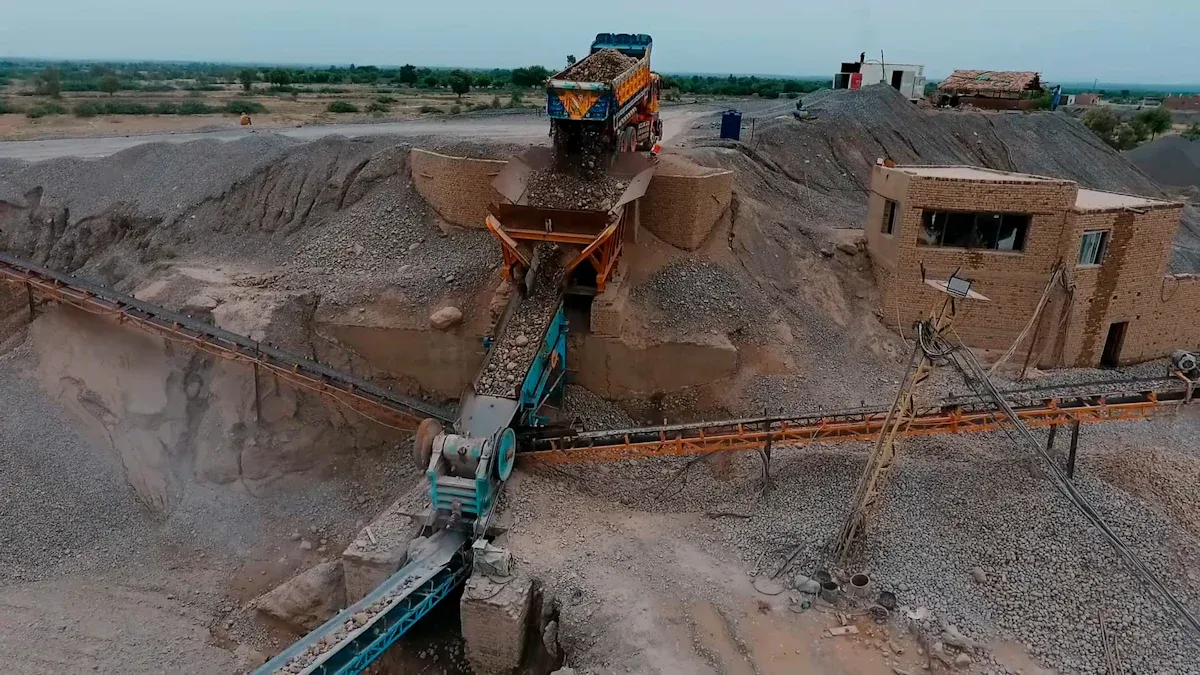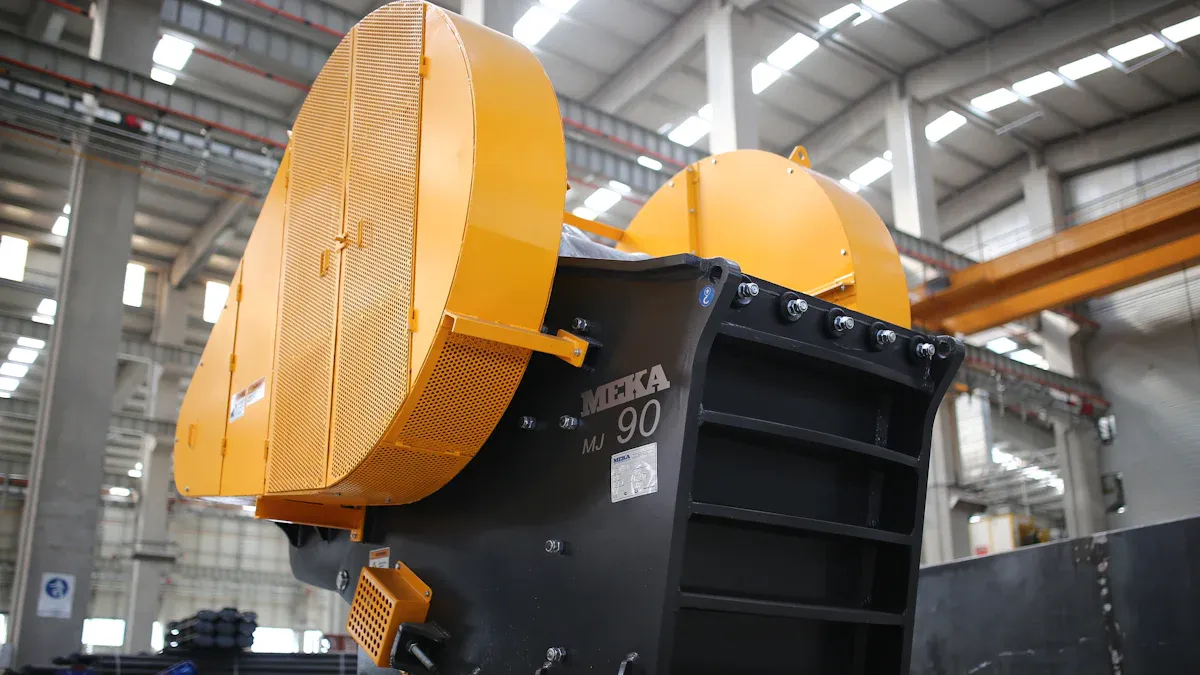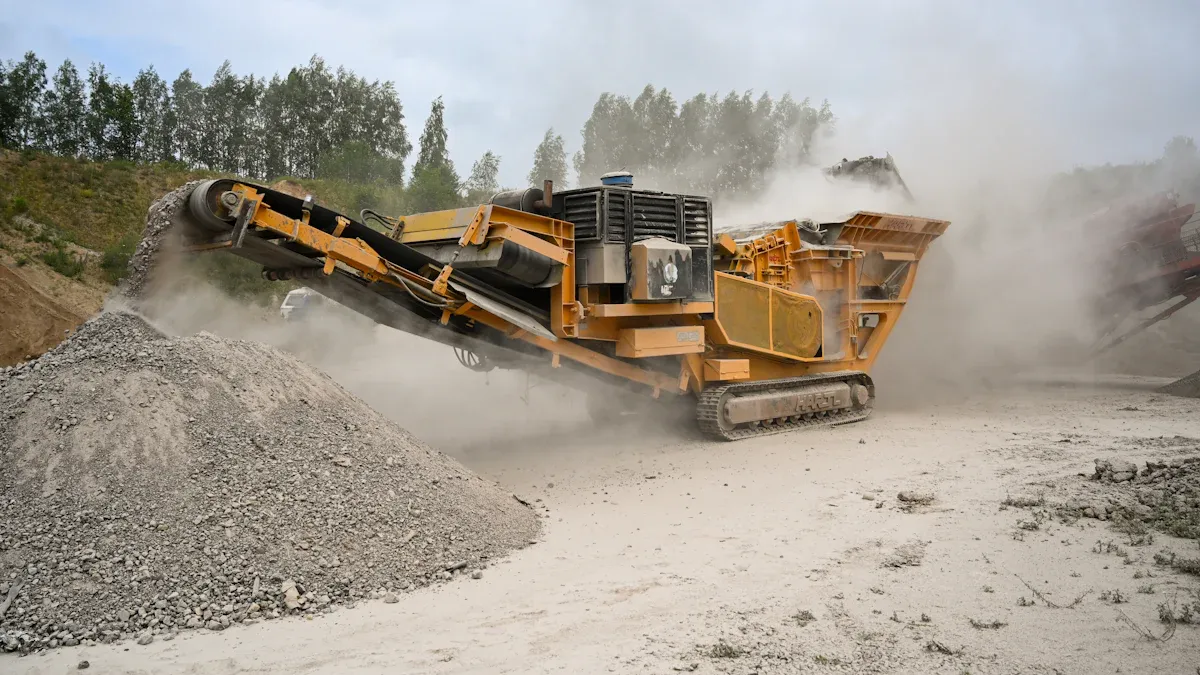Jaw Crusher Machine

A jaw crusher machine uses manganese steel and casting material to crush big rocks into smaller pieces. Crusher wear parts and crusher blow bars help it work hard every day. People get consistent results without extra effort. This machine makes tough jobs much easier for everyone.
Key Takeaways
- A jaw crusher machine crushes large rocks into smaller pieces using strong jaws, making tough jobs easier and saving manual labor.
- Operators can adjust the machine’s settings to control the size of crushed material, ensuring consistent and high-quality output.
- The machine’s simple design and safety features reduce maintenance time and protect workers, boosting productivity and reliability.
Jaw Crusher Machine: Working Principle
The Crushing Process
A Jaw Crusher Machine works by squeezing rocks between two strong plates. One plate stays still, while the other moves back and forth. This movement forms a V-shaped chamber. Large rocks enter from the top. The moving jaw pushes the rocks against the fixed jaw, crushing them into smaller pieces. The crushed material drops down and exits through the bottom opening.
Here’s how the process happens step by step:
- The motor powers an eccentric shaft, which moves the pitman.
- The pitman drives the movable jaw in a back-and-forth motion.
- When the jaws close, they crush the material.
- When the jaws open, the crushed pieces fall down by gravity.
- The discharge opening at the bottom controls the size of the output.
Tip: The flywheel helps keep the motion smooth and steady, so the Jaw Crusher Machine can crush rocks without stopping.
This simple design allows the machine to work continuously. Operators can adjust the discharge opening to get the desired size of crushed material. The toggle plate and pitman transfer force to the movable jaw, making sure the crushing action stays powerful.
Feed, Compression, and Output
The way material enters the Jaw Crusher Machine affects how well it works. If the feed lines up with the opening, rocks move smoothly into the chamber. Choke feeding keeps the chamber at least 80% full, which helps the machine crush more material and improves the shape of the output. Removing oversized rocks and pre-screening fines prevents clogging and keeps production steady.
Compression plays a key role in breaking down tough materials. The moving jaw presses the rocks against the stationary jaw, squeezing them until they break apart. This action narrows the gap between the jaws, crushing the material into smaller pieces. The V-shaped chamber, with a wide top and narrow bottom, controls how much the rocks get crushed.
A well-graded feed helps the Jaw Crusher Machine run smoothly. Operators avoid feeding lightweight or sticky materials, which can build up on the jaw plates and slow down the process. Limiting metal content in the feed protects the machine from damage.
| Feed Method | Effect on Efficiency | Output Quality |
|---|---|---|
| Choke Feeding | High throughput, steady flow | Uniform size, good shape |
| Trickle Feeding | Lower throughput | Less uniform, more fines |
| Pre-screening | Prevents clogging | Consistent output |
The compression process makes the Jaw Crusher Machine perfect for reducing large, hard rocks. The crushed material exits through the discharge opening, ready for further processing or transport.
Jaw Crusher Machine: Main Components

Fixed Jaw and Movable Jaw
The heart of every Jaw Crusher Machine lies in its two jaws. The fixed jaw stays in place, forming a sturdy surface for crushing. The movable jaw swings back and forth, pressing material against the fixed jaw. This action breaks rocks into smaller pieces. The fixed jaw usually stands upright or leans slightly outward, giving stability. The movable jaw tilts and moves in a special pattern, making the crushing chamber wide at the top and narrow at the bottom. This design helps material enter easily and exit smoothly. If the movable jaw has a smart shape and motion, the machine crushes better and lasts longer.
Note: A deep crushing chamber keeps material inside longer, which improves the crushing effect and saves energy.
| Component | Function | Key Notes |
|---|---|---|
| Fixed Jaw Plate | Stationary surface for crushing | Made of high manganese steel for durability |
| Movable Jaw Plate | Moves to crush material against the fixed jaw | Driven by eccentric shaft; key for efficiency |
Toggle Plate and Drive System
The toggle plate acts like a safety switch. If something too hard enters the crusher, the toggle plate breaks or bends, protecting the machine from damage. Regular checks and replacements keep the crusher safe and working well. The drive system powers the movable jaw. Modern machines use electric or hybrid drives to save energy and cut costs. These systems let operators control speed and rotation, making the crusher flexible and efficient. Features like automatic overload protection and gap adjustment help the machine run smoothly and avoid breakdowns.
- Hybrid drives lower fuel use and maintenance costs.
- Direct electric motors boost energy efficiency.
- Smart systems adjust power based on material hardness.
Discharge Opening and Output Control
The discharge opening sits at the bottom of the Jaw Crusher Machine. Operators can adjust this gap to control the size of the crushed material. A smaller opening makes finer output, while a larger gap produces coarser pieces. Adjustments happen by changing plate positions or wedge blocks. Regular tweaks keep the output size steady, even as parts wear down. The speed of the crusher also affects how fast material leaves the chamber. Keeping the right gap and speed ensures the machine delivers the desired product size every time.
| Discharge Opening Size | Throughput (tons/hr) | Capacity Factor (%) |
|---|---|---|
| Smaller (finer) | Lower | ~69 |
| Larger (coarser) | Higher | ~58 |
Tip: Adjusting the discharge opening helps match the output to different project needs and keeps production consistent.
Jaw Crusher Machine: Efficiency in Material Processing

Reducing Manual Labor
A Jaw Crusher Machine makes tough jobs easier for workers. The machine has fewer moving parts than other crushers, so it needs less fixing and fewer repairs. Workers spend less time on maintenance because quick-detachable jaw plates and modular toggle systems allow fast changeovers—sometimes in just ten minutes. Hydraulic adjustment systems and automated overload protection also help. Operators can change settings with the push of a button, which means less heavy lifting and fewer manual tasks.
Operators feel safer because advanced safety systems and remote controls reduce the need for hands-on work. Machines with easy access panels and modular parts let workers fix problems quickly, saving time and effort.
Here are some ways a Jaw Crusher Machine saves labor:
- Over 60% fewer moving parts than gyratory or impact crushers.
- Hydraulic gap adjustment and automatic wear recovery systems.
- Remote control and diagnostics for faster troubleshooting.
- Reversible jaws clear blockages quickly.
- Regular check-ups and planned maintenance reduce breakdowns.
Consistent Output Size
A Jaw Crusher Machine delivers uniform product size, even when crushing different materials like granite or concrete. Operators can adjust the discharge opening, called the closed-side setting (CSS), to control the output size. This adjustment helps keep the product size steady, no matter the material hardness.
| CSS Setting (mm) | Typical Output Size (mm) | Capacity Impact |
|---|---|---|
| 100 | 150-200 | Maximizes throughput |
| 50 | 75-100 | Reduces capacity by 25% |
| 25 | 35-50 | Capacity drops 40-50% |
Operators use product gradation curves to predict and control output size. By choosing the right CSS, they can plan for secondary crushing or sort products for sale. Modern tools like laser CSS measurement and wear compensation software help keep output size precise. Monitoring jaw plate wear is important because worn plates can make the output larger than expected.
Quick hydraulic adjustments mean less downtime and more consistent results, even when switching between different materials.
High Throughput and Productivity
A Jaw Crusher Machine handles large volumes of material quickly. It works best during the primary crushing stage, breaking down tough rocks and coarse materials. The machine’s high throughput keeps production lines moving and prevents bottlenecks.
Jaw crushers offer a reduction ratio of 3:1 to 6:1. They process hard and abrasive materials with ease. When operators set the machine for finer output, throughput drops, but the machine still works efficiently. Gyratory crushers can handle even higher tonnage, but jaw crushers remain popular for their simplicity and reliability.
Here’s how productivity impacts operations:
- High throughput keeps material flowing and avoids stoppages.
- Fewer moving parts mean less maintenance and lower costs.
- Versatility allows the machine to handle many types of materials.
- On-site crushing reduces transportation needs and speeds up production.
- Safety and automation features protect workers and equipment.
- Digital monitoring supports predictive maintenance and reduces downtime.
- Modular design fits different production scales.
- Environmental features help companies meet regulations.
| Factor Affecting Productivity | Description | Impact on Production | Estimated Revenue Loss (Example) |
|---|---|---|---|
| Bridging (material blockage) | Stones blocking feed flow cause production stoppages | Up to 1 hour lost per day | ~$4,000 per day |
| Jaw Die Profile Selection | Proper die profiles optimize crushing for different rock types | Can save over 20% of production capacity | $4,000 to $8,000 per day |
| Jaw Condition Monitoring | Worn jaws reduce crushing efficiency and increase downtime | 10–20% reduction if neglected | $4,000 to $8,000 per day |
Types of Jaw Crusher Machines and Application Fit
Jaw Crusher Machines come in several types, each designed for specific jobs. Single toggle jaw crushers have a simple design and fewer moving parts, making them efficient for medium-hard to hard materials. Double toggle jaw crushers use two toggle plates for extra crushing force, which helps with very hard and abrasive materials. Mobile jaw crushers are mounted on tracks or wheels, so they can move easily for on-site crushing. Mini jaw crushers work well in labs or small-scale projects.
The right type of Jaw Crusher Machine depends on the material, desired output size, and production needs. Operators should look for features like robust construction, adjustable settings, and safety systems.
- Single toggle: Simple, efficient, good for medium-hard materials.
- Double toggle: Stronger, better for tough and abrasive rocks.
- Mobile: Flexible, ideal for mining and construction sites.
- Mini/laboratory: Compact, perfect for testing and small batches.
Jaw crushers work in many industries, including mining, quarrying, construction, recycling, and aggregate production. Their versatility and adaptability make them a top choice for material processing.
A Jaw Crusher Machine streamlines material processing by automating tough tasks. Operators see benefits like:
- Real-time monitoring for safer, smoother runs
- Consistent output size for better product quality
- Less manual effort, which boosts safety and productivity
Choosing the right model ensures the best fit for every job.
FAQ
How often should someone replace jaw plates on a jaw crusher machine?
Most operators check jaw plates every week. They replace them when wear reaches 80%. Regular checks help the machine work better and last longer.
Can a jaw crusher handle wet or sticky materials?
A jaw crusher can process some wet material. Sticky or muddy feed may cause blockages. Operators often pre-screen or dry the material first.
What safety features do modern jaw crushers offer?
| Feature | Benefit |
|---|---|
| Automatic overload | Prevents damage |
| Remote controls | Keeps operators safe |
| Hydraulic adjustment | Reduces manual effort |
Post time: Aug-11-2025